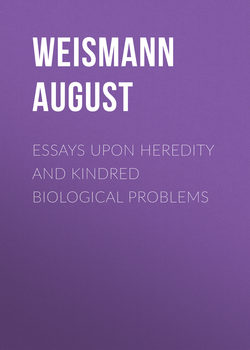Читать книгу Essays Upon Heredity and Kindred Biological Problems - Weismann August - Страница 8
I.
THE DURATION OF LIFE.
1881
APPENDIX
Note 3. The Duration of Life among Mature Insects
I. Orthoptera
ОглавлениеGryllotalpa. The eggs are laid in June or July, and the young are hatched in from two to three weeks; they live through the winter, and become sexually mature in the following May or June. ‘When the female has deposited her eggs, her body collapses, and afterwards she does not survive much longer than a month.’ ‘According as the females are younger or older, they live a longer or shorter life, and hence some females are even found in the autumn’ (Rösel, ‘Insektenbelustigungen,’ Bd. II. p. 92). Rösel believes that the female watches the eggs until they are hatched, and this explains the fact that she outlives the process of oviposition by about a month. It is not stated whether the males die at an earlier period.
Gryllus campestris becomes sexually mature in May, and sings from June till October, ‘when they all die’ (Oken, ‘Naturgeschichte,’ Bd. II. Abth. iii. p. 1527). It is hardly probable that any single individual lives for the whole summer; probably, as in the case of Gryllotalpa, the end of the life of those individuals which first become mature, overlaps the beginning of the life of others which reach maturity at a later date.
Locusta viridissima and L. verrucivora are mature at the end of August; they lay their eggs in the earth during the first half of September and then die. It is probable that the females do not live for more than four weeks in the mature state. It is not known whether the males of this or other species of locusts live for a shorter period.
I have found Locusta cantans in plenty, from the beginning of September to the end of the month. In captivity they die after depositing their eggs: the males are probably more short-lived, for towards the middle and end of September they are much less plentiful than the females.
Acridium migratorium ‘dies after the eggs are laid’ (Oken, ‘Naturgeschichte’).
The male Termes probably live for a short time only, although exact observations upon the point are wanting. The females ‘seem sometimes to live four or five years,’ as I gather from a letter from Dr. Hagen, of Cambridge, Mass., U.S.A.
Ephemeridae. Rösel, speaking of Ephemera vulgata (‘Insektenbelustigungen,’ Bd. II. der Wasserinsekten, 2te Klasse, p. 60 et seq.), says:—‘Their flight commences at sunset, and comes to an end before midnight, when the dew begins to fall.’ ‘The pairing generally takes place at night and lasts but a short time. As soon as the insects have shed their last skin, in the afternoon or evening, they fly about in thousands, and pair almost immediately; but by the next day they are all dead. They continue to emerge for many days, so that when yesterday’s swarm is dead, to-day a new swarm is seen emerging from the water towards the evening.’ ‘They not only drop their eggs in the water, but wherever they may happen to be,—on trees, bushes, or the earth. Birds, trout and other fish lie in wait for them.’
Dr. Hagen writes to me—‘It is only in certain species that life is so short. The female Palingenia does not live long enough to complete the last moult of the sub-imago. I believe that a female imago has never been seen. The male imago, often half in its sub-imago skin, fertilizes the female sub-imago and immediately the contents of both ovaries are extruded, and the insect dies. It is quite possible that the eggs pass out by rupturing the abdominal segments.’
Libellula. All dragon-flies live in the imago condition for some weeks; at first they are not capable of reproduction, but after a few days they pair.
Lepisma saccharina. An individual lived for two years in a pill-box, without any food except perhaps a little Lycopodium dust9.
9
‘Entomolog. Mag.,’ vol. i. p. 527, 1833.
